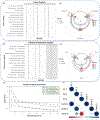Heterogeneity in caregiving-related early adversity: Creating stable dimensions and subtypes
- PMID: 35314012
- PMCID: PMC9492894
- DOI: 10.1017/S0954579421001668
Heterogeneity in caregiving-related early adversity: Creating stable dimensions and subtypes
Abstract
Early psychosocial adversities exist at many levels, including caregiving-related, extrafamilial, and sociodemographic, which despite their high interrelatedness may have unique impacts on development. In this paper, we focus on caregiving-related early adversities (crEAs) and parse the heterogeneity of crEAs via data reduction techniques that identify experiential cooccurrences. Using network science, we characterized crEA cooccurrences to represent the comorbidity of crEA experiences across a sample of school-age children (n = 258; 6-12 years old) with a history of crEAs. crEA dimensions (variable level) and crEA subtypes (subject level) were identified using parallel factor analysis/principal component analysis and graph-based Louvain community detection. Bagging enhancement with cross-validation provided estimates of robustness. These data-driven dimensions/subtypes showed evidence of stability, transcended traditional sociolegally defined groups, were more homogenous than sociolegally defined groups, and reduced statistical correlations with sociodemographic factors. Finally, random forests showed both unique and common predictive importance of the crEA dimensions/subtypes for childhood mental health symptoms and academic skills. These data-driven outcomes provide additional tools and recommendations for crEA data reduction to inform precision medicine efforts in this area.
Keywords: caregiving related early adversities; heterogeneity; prediction; subtyping.
Conflict of interest statement
Figures





References
-
- Aber JL (2013). Family and community level effects. In Nelson CA (Ed.), Threats to optimal development: Integrating biological, psychological, and social risk factors: The Minnesota symposia on child psychology (vol. 27, pp. 229). Psychology Press.
-
- Achenbach TM, & Rescorla LA Eds (2001). Manual for the Aseba school-age forms & profiles. University of Vermont, Research Center for Children, Youth, & Families.
-
- Barnet O, Miller-Perrin CL, & Perrin RD (2005). Child psychological maltreatment. In Barnett O, Miller-Perrin CL, & Perrin RD (Eds.), Family violence across the lifespan: An introduction (2nd edn., pp. 151–178). Sage Publications.
Publication types
MeSH terms
Grants and funding
LinkOut - more resources
Full Text Sources
Medical

